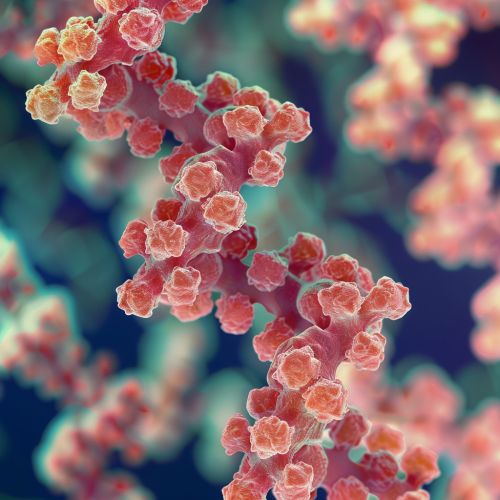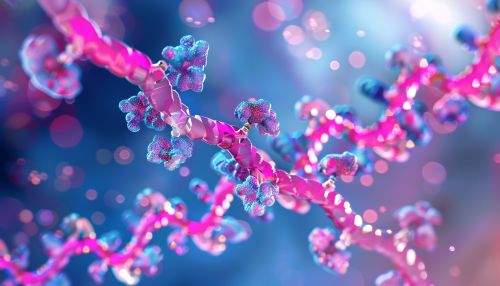Tubulin
Introduction
Tubulin is a globular protein that is a key structural component of microtubules, which are essential elements of the cytoskeleton in eukaryotic cells. This protein plays a crucial role in various cellular processes, including intracellular transport, cell division, and the maintenance of cell shape. Tubulin exists in several isoforms, the most common of which are alpha-tubulin and beta-tubulin. These isoforms polymerize to form microtubules, which are dynamic structures that undergo continuous assembly and disassembly.
Structure and Isoforms
Tubulin is a dimer composed of two closely related subunits: alpha-tubulin and beta-tubulin. Each subunit has a molecular weight of approximately 50 kDa and consists of around 450 amino acids. The structure of tubulin has been extensively studied using techniques such as X-ray crystallography and cryo-electron microscopy. These studies have revealed that both alpha- and beta-tubulin have a similar three-dimensional structure, characterized by a core of beta-sheets surrounded by alpha-helices.
Alpha-Tubulin
Alpha-tubulin is one of the two main isoforms of tubulin. It contains a GTP-binding site that is crucial for its function. The GTP bound to alpha-tubulin is not hydrolyzed and remains in the nucleotide-binding pocket, providing stability to the tubulin dimer.
Beta-Tubulin
Beta-tubulin is the other main isoform of tubulin. Unlike alpha-tubulin, the GTP bound to beta-tubulin is hydrolyzed to GDP during the polymerization process. This hydrolysis is a key factor in the dynamic instability of microtubules, allowing them to rapidly grow and shrink.


Microtubule Dynamics
Microtubules are dynamic polymers composed of tubulin dimers. They exhibit a property known as dynamic instability, characterized by phases of growth and shrinkage. This dynamic behavior is essential for many cellular processes, including mitosis, intracellular transport, and cell motility.
Polymerization and Depolymerization
Microtubule polymerization begins with the nucleation of tubulin dimers, followed by the addition of more dimers to the growing microtubule end. This process is GTP-dependent, with GTP-bound tubulin dimers adding to the microtubule plus end. Once incorporated, the GTP on beta-tubulin is hydrolyzed to GDP, which destabilizes the microtubule and can lead to depolymerization.
Dynamic Instability
Dynamic instability refers to the rapid transition between growth and shrinkage of microtubules. This behavior is regulated by various factors, including the concentration of tubulin dimers, the presence of microtubule-associated proteins (MAPs), and post-translational modifications of tubulin. The GTP cap at the growing end of the microtubule plays a critical role in stabilizing the structure and preventing catastrophic depolymerization.
Functional Roles
Tubulin and microtubules are involved in a wide range of cellular functions. These include:
Intracellular Transport
Microtubules serve as tracks for the transport of organelles, vesicles, and other cargo within the cell. Motor proteins such as kinesin and dynein move along microtubules, carrying cargo to specific destinations. This transport system is essential for maintaining cellular organization and function.
Cell Division
During mitosis, microtubules form the mitotic spindle, which is responsible for segregating chromosomes into daughter cells. The dynamic nature of microtubules allows them to rapidly reorganize and capture chromosomes, ensuring accurate chromosome segregation.
Cell Shape and Motility
Microtubules contribute to the maintenance of cell shape by providing structural support. They also play a role in cell motility, particularly in the formation and function of cilia and flagella, which are microtubule-based structures involved in cell movement and fluid flow.
Post-Translational Modifications
Tubulin undergoes various post-translational modifications that regulate its function and interactions with other proteins. These modifications include acetylation, detyrosination, polyglutamylation, and phosphorylation.
Acetylation
Acetylation of tubulin occurs on the lysine residue of alpha-tubulin. This modification is associated with stable microtubules and is thought to play a role in regulating microtubule dynamics and interactions with motor proteins.
Detyrosination
Detyrosination involves the removal of the C-terminal tyrosine residue from alpha-tubulin. This modification affects the binding of microtubule-associated proteins and motor proteins, influencing microtubule stability and function.
Polyglutamylation
Polyglutamylation is the addition of glutamate residues to the C-terminal tail of tubulin. This modification is involved in regulating the interactions between microtubules and motor proteins, as well as the stability of microtubules.
Phosphorylation
Phosphorylation of tubulin occurs on specific serine and threonine residues. This modification can affect tubulin polymerization and interactions with other proteins, playing a role in the regulation of microtubule dynamics.
Tubulin-Binding Drugs
Several drugs target tubulin and microtubules, making them important tools in cancer therapy and research. These drugs can be classified into two main categories: microtubule-stabilizing agents and microtubule-destabilizing agents.
Microtubule-Stabilizing Agents
Microtubule-stabilizing agents, such as paclitaxel (Taxol), bind to tubulin and promote microtubule polymerization. These drugs stabilize microtubules, preventing their depolymerization and interfering with cell division. They are commonly used in the treatment of various cancers.
Microtubule-Destabilizing Agents
Microtubule-destabilizing agents, such as vinblastine and colchicine, bind to tubulin and inhibit microtubule polymerization. These drugs disrupt microtubule dynamics, leading to cell cycle arrest and apoptosis. They are used in cancer therapy and as research tools to study microtubule function.
Tubulin in Disease
Mutations and dysregulation of tubulin can lead to various diseases, including neurodegenerative disorders and cancer.
Neurodegenerative Disorders
Abnormalities in tubulin and microtubule function are implicated in several neurodegenerative disorders, such as Alzheimer's disease and Parkinson's disease. These conditions are characterized by the accumulation of abnormal protein aggregates and the disruption of neuronal transport and function.
Cancer
Tubulin is a target for many anticancer drugs due to its essential role in cell division. Mutations in tubulin genes can lead to drug resistance in cancer cells, making it a focus of research for developing new therapeutic strategies.
Research and Future Directions
Research on tubulin and microtubules continues to advance our understanding of cellular processes and disease mechanisms. Future directions include the development of new tubulin-targeting drugs, the study of tubulin isoforms and their specific functions, and the exploration of tubulin's role in various cellular pathways.
